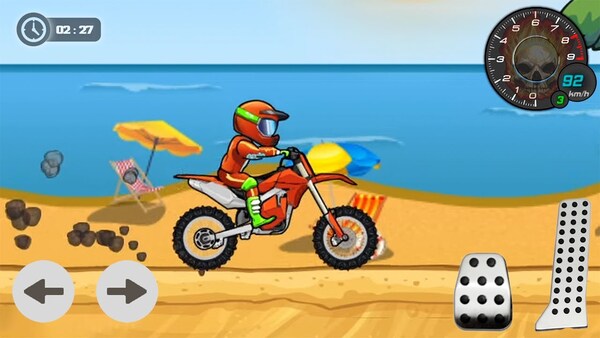Grand Vegas Simulator: The Ultimate Open-World Casino Crime Adventure
In the sprawling world of mobile simulation games,
Grand Vegas Simulator emerges as a bold fusion of gambling, crime, and sandbox freedom. Combining the high-octane chaos of open-world crime titles with the neon-lit allure of Las Vegas-style casinos, this game invites players to live the life of a rogue gambler, hustler, and thrill-seeking adventurer. From the bustling streets of Vegas to secret hideouts and poker dens, the game offers an intense roleplaying experience packed with driving missions, heists, casino management, and gritty survival elements. As mobile gaming advances in complexity,
Grand Vegas Simulator seeks to redefine what open-world sandbox games can offer on handheld devices.
Getting Started: Entering the World of Grand Vegas
Right from the beginning, players are thrust into the neon-lit heart of Grand Vegas, a city alive with temptation, violence, and golden opportunity. Upon launching the game, you create your character, customizing their looks, attire, and origin story.
As you step onto the streets, you’re greeted with side quests, introductory missions, and NPC interactions that slowly ease you into the criminal underworld. Additionally, tutorial missions are cleverly embedded into early tasks, teaching you how to drive, gamble, use weapons, and interact with the city’s systems.
Furthermore, the introductory narrative quickly establishes your motivations: earn money, rise through the underworld ranks, and eventually control the city’s elite gambling scene. This immediate goal helps anchor your experience and makes each activity feel like a step toward empire-building.
Open-World Exploration: More Than Just a Casino City
The game's map is impressively vast and detailed. Unlike many mobile simulators that focus solely on either city or mission hubs,
Grand Vegas Simulator grants players the freedom to explore casinos, seedy alleyways, luxury hotels, deserts, and high-security vaults.
Moreover, the variety of environments helps break the monotony of traditional mission-based games. Whether you’re evading cops in a high-speed chase or sneaking into a rival’s penthouse, the world reacts to your choices. Consequently, your decisions alter NPC behavior and trigger dynamic events.
Additionally, the sandbox nature of the game means that you're never truly forced into linearity. You can engage in side hustles, take up gigs, or simply explore the Vegas nightlife for hours.
Driving Mechanics: Cruising in Style or Escaping Chaos
Driving is a central mechanic in
Grand Vegas Simulator, and thankfully, it's well-executed. With a wide range of vehicles—sports cars, limousines, motorcycles, and even armored vans—the streets are your playground.
Not only does each vehicle feel different in terms of handling and speed, but there’s also a damage system that adds realism. Crashing into a street pole doesn’t just bounce you back—it can wreck your vehicle, stall the engine, and attract police attention.
In addition, the missions incorporate vehicular elements brilliantly. From timed races to casino getaway runs, driving is never just for fun—it’s often integral to survival and success.
Casino Gameplay: High Stakes and High Rewards
No Vegas-themed game would be complete without immersive casino gameplay. Fortunately, this is where
Grand Vegas Simulator truly shines. Players can visit multiple casinos, each with its own set of games, security protocols, and clientele.
You’ll engage in poker, blackjack, roulette, and high-risk slot machines. What’s more, gambling isn’t just a mini-game; it’s often tied to storyline quests and character development. For instance, winning a major poker tournament might give you access to elite missions or new contacts.
Also, the game implements a realistic in-game economy, where players must manage winnings, losses, debts, and laundered money. This adds a tactical layer to the casino system that goes far beyond luck.
Combat and Crime: From Street Brawls to Armed Heists
While gambling is central to your rise in Vegas, crime solidifies your position. As you progress, you'll unlock combat mechanics including melee fighting, stealth takedowns, and gunplay. Missions often revolve around theft, extortion, or even full-blown armed robberies.
Combat, while not revolutionary, is fluid and satisfying. In fact, timing, weapon choice, and location all affect outcomes. You’re also given access to a variety of gear—smoke bombs, silencers, EMPs, and assault rifles.
Even more impressively, certain missions let you choose your approach: go loud and chaotic, or silent and strategic. This branching design elevates the immersion and replayability.
Heist Missions: Planning, Execution, and Escape
Eventually, you’ll gain access to the most adrenaline-fueled missions in the game—heists. These require multi-step planning, including surveillance, gathering a crew, securing equipment, and infiltrating the location.
Heist missions are layered and often require real-time decisions. For example, if an NPC guard sees you, do you bribe them, knock them out, or reroute? These micro-decisions create branching outcomes that feel both tense and rewarding.
Moreover, the aftermath of a heist isn’t always glamorous. You may face police chases, betrayal from crew members, or new rival factions trying to claim your stolen loot. These post-mission consequences add significant depth to the story.
Upgrades and Customization: Personalizing Power and Style
Customization goes far beyond appearance in
Grand Vegas Simulator. You can upgrade your vehicles, weapons, safehouses, and casino holdings.
For example, your penthouse can evolve from a dingy one-room flat into a luxury command center complete with guards, vaults, and underground passageways. Weapon mods let you increase damage, silence shots, or enhance reload speeds.
Even more interestingly, your decisions impact what upgrades become available. Invest in casino holdings, and you unlock chips faster. Focus on combat, and you'll gain access to exclusive black market dealers. This progression feels meaningful and personal.
Story and Dialogue: Choices with Lasting Impact
Despite its chaotic nature,
Grand Vegas Simulator offers a surprisingly deep narrative. Characters have backstories, motivations, and complex relationships. Whether you choose to betray a friend for profit or spare an enemy out of honor, the story adapts.
Dialogue choices are frequent, and they influence more than just the current conversation. In fact, factions may ally or turn against you based on earlier choices. This branching narrative lends weight to decisions and increases replay value.
Furthermore, voice acting and character animations, though not AAA level, are solid enough to carry the emotion and stakes of each scene.
Multiplayer and Online Features: Compete or Collaborate
Multiplayer functionality is robust. You can join friends in co-op missions, compete in online tournaments, or explore the city together.
Interestingly, there’s even a gang system, where players can form criminal syndicates and control territories. Online leaderboards add competitiveness, while co-op gameplay allows for strategic coordination during heists.
However, latency can sometimes affect synchronization, especially in intense missions. Still, the online component expands longevity and community engagement.
Recent Updates and Future Roadmap
As of 2024–2025, several major updates have expanded the game's scope. New casino interiors, enhanced police AI, and the “Downtown Heist Pack” were added. Additionally, new character animations and story arcs deepen immersion.
Furthermore, developers have confirmed that future expansions will include a second city, cross-server multiplayer, and virtual reality support. These additions show that
Grand Vegas Simulator is not a stagnant game—it’s a living, evolving platform.
Also, developers frequently engage with fans on social media, implementing feedback and fixing bugs quickly. This active communication ensures the game remains fresh and community-driven.
Pros and Cons of Grand Vegas Simulator
✅
Pros
- Massive open world with dynamic environments
- Rich casino gameplay with real stakes
- Deep character progression and customization
- Robust combat and heist mechanics
- Strong multiplayer integration
❌
Cons
- Occasional bugs and latency issues
- In-app purchases can unbalance progression
- Some missions lack variety after extended play
- Graphics fall short of console standards
Final Verdict and Rating
Ultimately,
Grand Vegas Simulator delivers a compelling experience for fans of open-world crime, gambling, and action. With its blend of high-stakes casino play, cinematic heists, and meaningful upgrades, it strikes a balance between strategy and chaos. Even though some areas need refinement, the game’s scale, ambition, and support from developers make it one of the most impressive mobile sandbox games currently available.
Rating: 9.1/10
A high-stakes, high-reward adventure that turns your mobile device into a neon-drenched empire-building playground.
































